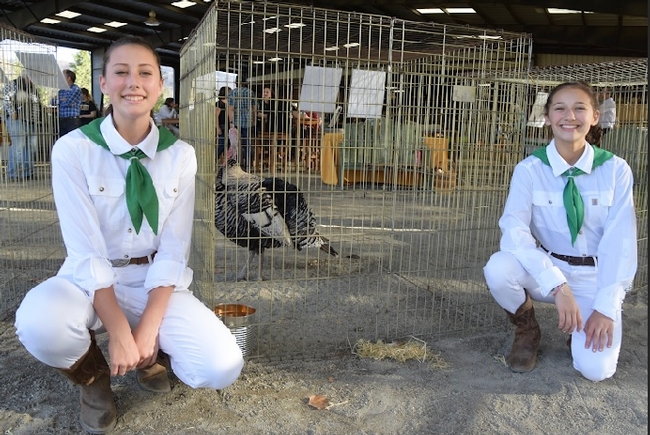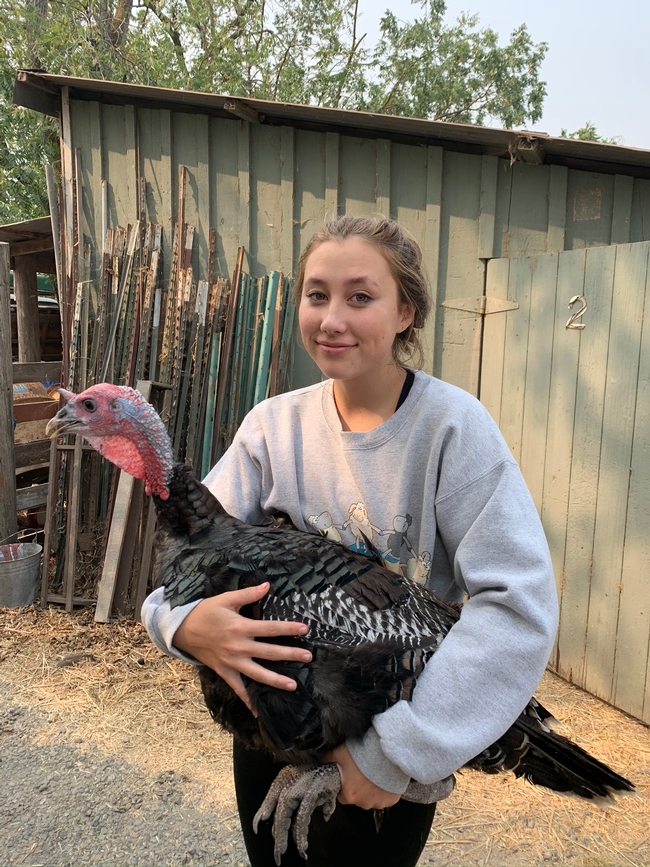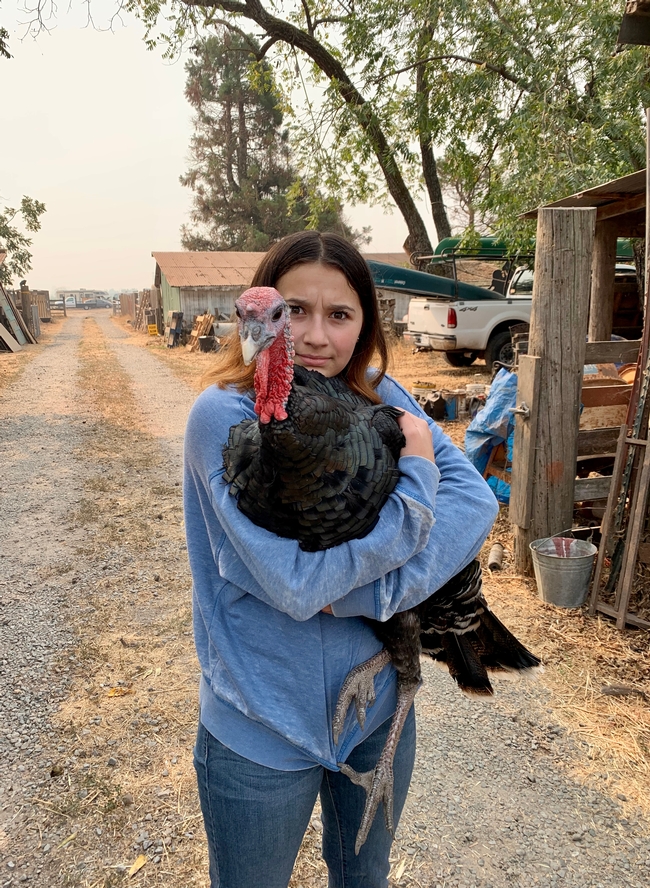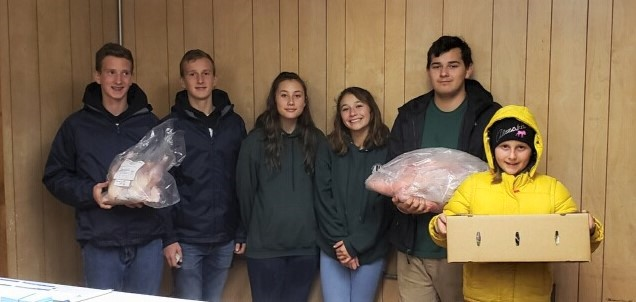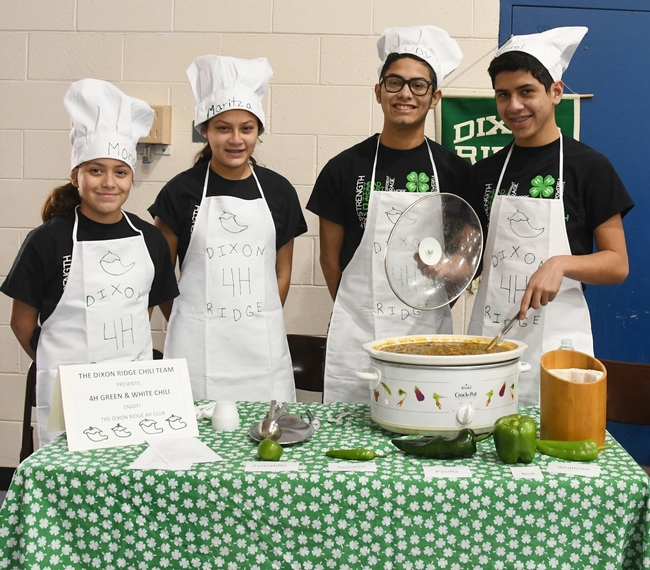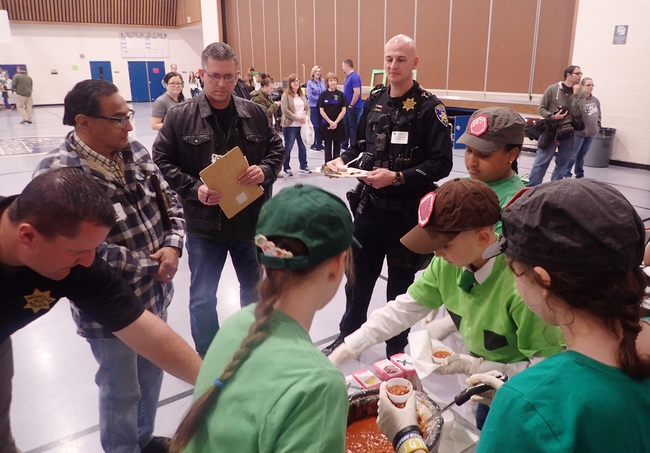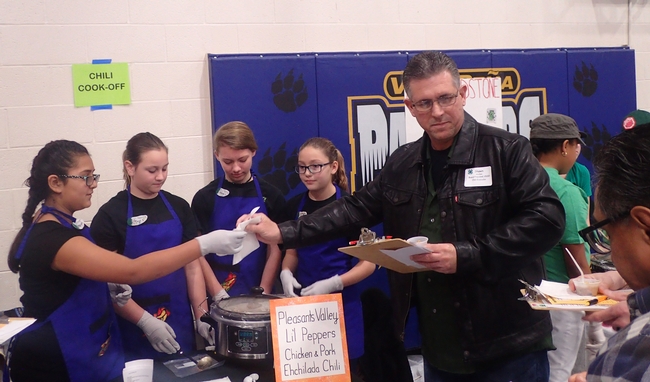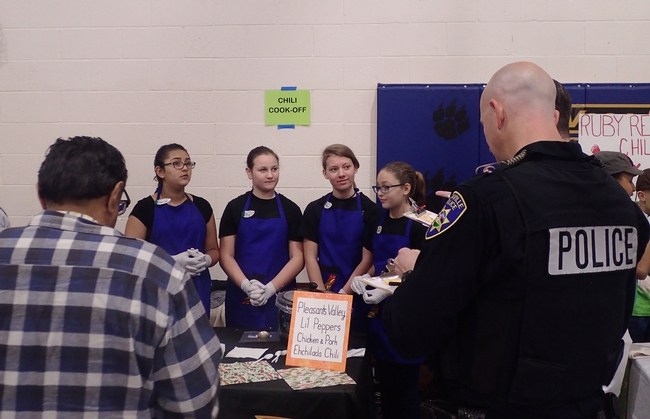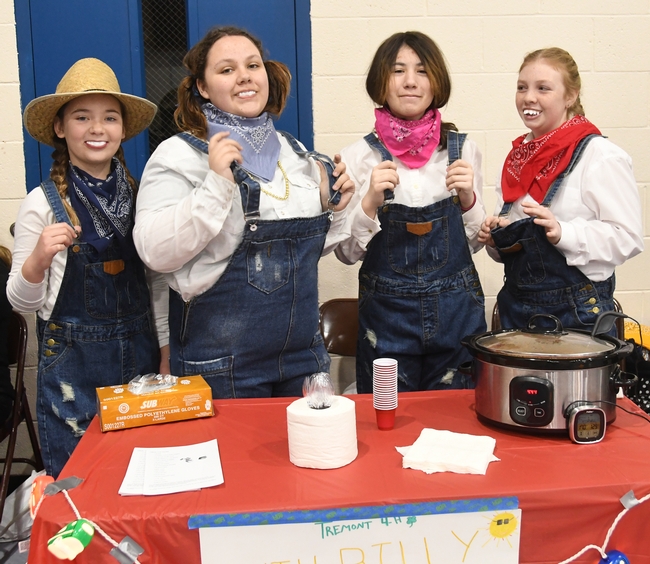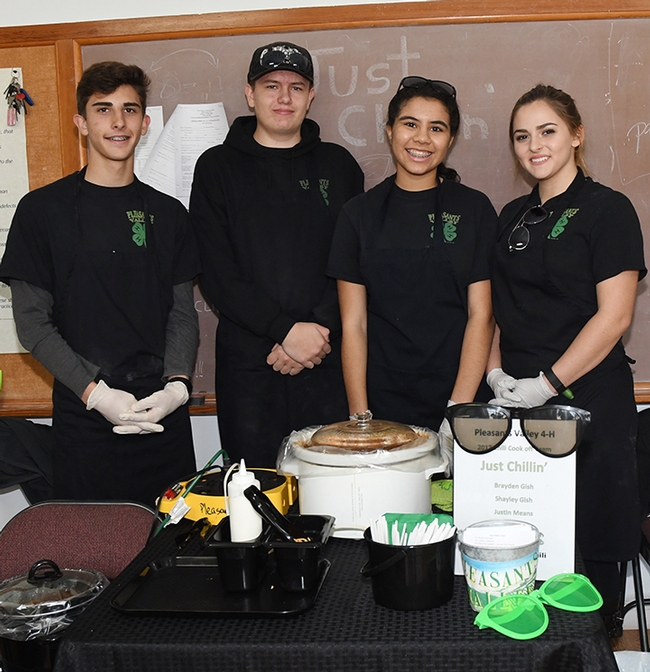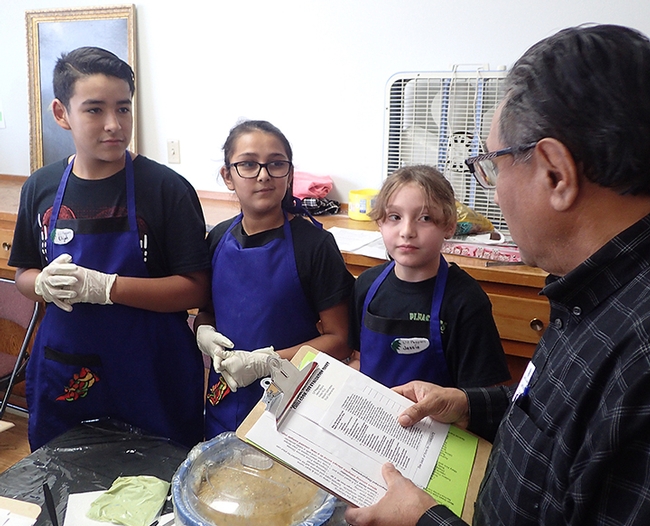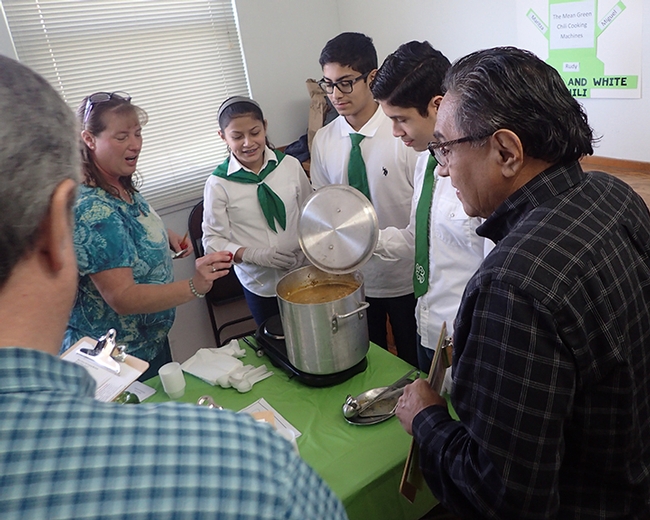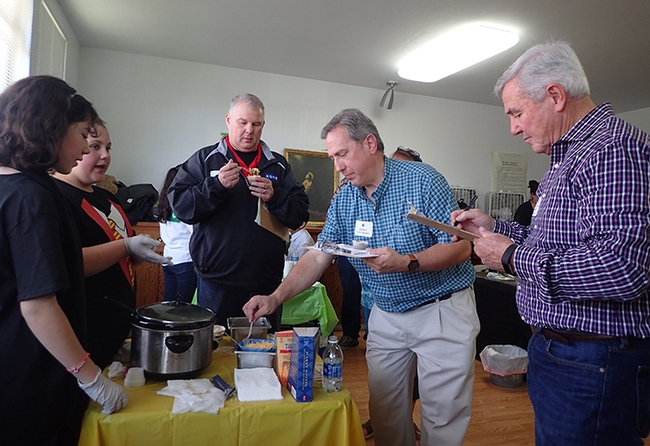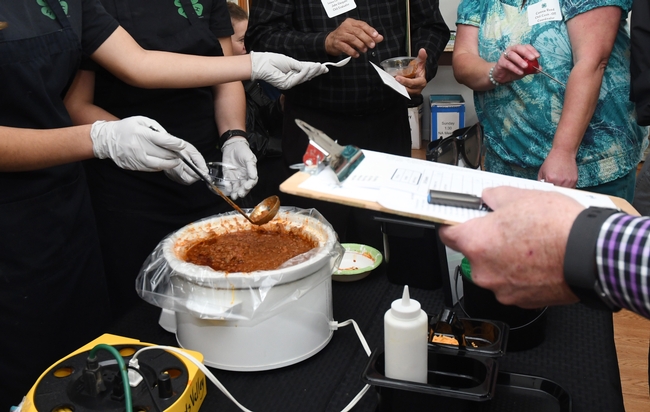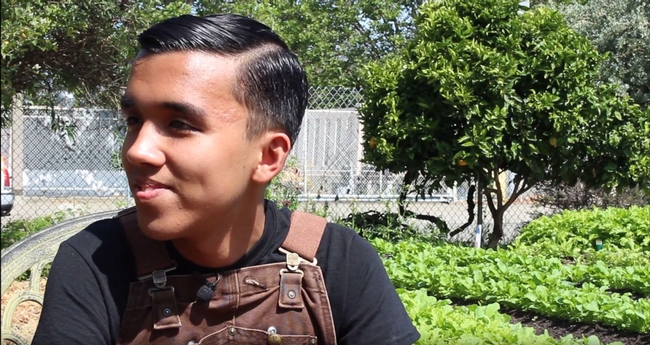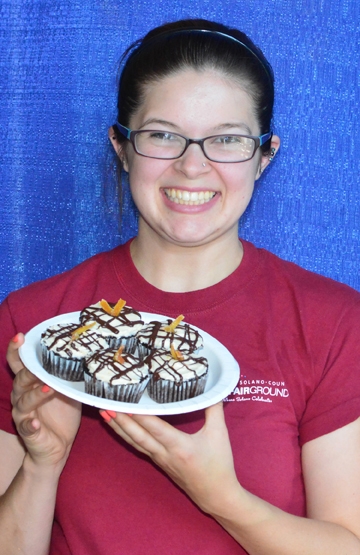Posts Tagged: Youth Development
4-H youths raise turkeys to save for college and learn about farming
While most Americans choose their Thanksgiving turkeys from the meat department at the local grocery store, Brylee Aubin and Yaxeli Saiz-Tapia can tell you the life histories of their holiday birds. The Sonoma County teenagers raise heritage turkeys together as part of a 4-H youth development project and sell them for Thanksgiving. For the last two years, Yaxeli's older brother Uli has joined the project and, between the three of them, they raised 47 turkeys this year.
The Heritage Turkey Project in Sonoma County has about 15 members of the UC Cooperative Extension's 4-H youth development program and the National FFA Organization growing more than 200 heritage turkeys this year, according to Catherine Thode, who has been leading the project for 15 years.
“Our project leaders are active breeders of heritage turkeys and some of our 4-H and FFA youth are now raising breeding pairs and hatching their own birds,” Thode said. “Each project member raises their small flock of birds on their own property and shoulders the responsibility of providing their feed and care.”
The Heritage Turkey Project promotes the preservation of heritage turkey breeds, sustainable farming and responsible animal husbandry. While raising the animals, the youths learn life skills and earn money for their work.
“The money I raise from raising and selling turkeys goes towards my college fund and to more 4-H projects like market goats or sheep,” said 15-year-old Brylee, who sells her turkeys for $9.50 per pound.
Three years ago, Brylee's neighbor, Yaxeli joined her in the heritage turkey project.
“I have learned how to care for animals, the importance of raising organic and the costs involved,” said Yaxeli, 14. “I have gained a firm understanding of how my birds are raised and processed versus corporate methods. Having the opportunity to participate in this project has strengthened my value for the importance of where my food comes from.”
Consumers benefit by getting turkeys that are farmed organically, fed high-quality grains, and never frozen, said Brylee.
“There are so many benefits to raising these beautiful birds,” said Uli Saiz-Tapia, 17. “First, you learn the cost of running a business, how to reinvest for the next year, the different stages of turkey growth and how to manage issues that arise such as the turkeys fighting, how they react to fluctuating temperatures, how to keep them safe and nourished properly. Learning about the process of getting our turkeys ready to be purchased has really benefitted my understanding of anatomy, the amount of work it takes in preparing them and the importance of not wasting food.”
The group sold out of turkeys in early November.
“Back in March, we really wondered if we should even do the project this year, not knowing what was going to happen with COVID restrictions and the impact on the economy,” Thode said. “We ended up with more project members than we've ever had, and over 200 turkeys to be sold for the Thanksgiving market.”
The 4-H members started the season with more turkeys, but lost some birds to predators. Wildfires seemed to drive more predators to the Sonoma County farms this year, she said.
“Things are fast and furious right now,” Thode said a week before Thanksgiving as the group prepared their turkeys for processing and distribution to people who placed orders. “I'm about to enter the busiest seven days of our year. It will take all weekend to have the birds processed, weighed, labeled. Then, we hunker down to sort and assign turkeys to our customer list.”
While selling turkeys, the group encourages customers to meet the farmers and to visit https://livestockconservancy.org/index.php/heritage/internal/conservation-priority-list#Turkeys to look up the history and breed characteristics of the turkey they are purchasing. In past years, some customers have taken photos of themselves with the person who raised their bird.
“We not only have a master list of customers and their desired sizes, but we create a spreadsheet for every project member with a list of the turkeys they've grown that year,” Thode said. “Each turkey is identified in the spring or early summer with a small metal wing band that lists the grower and an individual number for that turkey. When the turkey is sold, the buyer knows which project number grew their turkey, and the variety of turkey that they are purchasing. We think it's important that our customers know this. In fact, when they come to pick up their turkey, they write their check to the actual grower of their turkey.”
To learn more about the Heritage Turkey Project, visit https://heritageturkeyproject.webs.com.
4-H chili cookoff: Heralding green and white
What's green and white and wins a county 4-H chili cookoff?
Chili, 4-H chili.
And it's just in time for Super Bowl Sunday on Feb. 4 when the New England Patriots square off in Minneapolis, Minn., with the Philadelphia Eagles.
A sibling team from the Dixon Ridge 4-H Club won the 2018 Solano County 4-H Chili Cookoff with a recipe titled “4-H Green and White Chili," featuring pork shoulder and pork sausage and four different varieties of peppers. The five-team competition took place at the Pena Adobe Middle School, Vacaville, during the Solano County 4-H Project Skills Day.
The members of the Dixon championship chili team - Maritzia Partida Cisneros, Miguel Partida Cisneros, Moncerrat “Monce” Torres Cisneros and Rudolfo “Rudy” Radillo Cisneros - used four different green peppers: pasilla, Anaheim, serrano and green bell pepper to flavor and spice the white (pork) chili.
The siblings competed last year as the “Mean Green Machines,” wearing their official green and white 4-H uniforms and hats. This year they chose the same recipe but adjusted its heat. They also donned different 4-H attire along with white chef hats, inscribed with their names.
The Dixon Ridge team competed against Team Delta of the Rio Vista 4-H Club, which prepared “Chili-licious”; Hillbilly Chili Team from Tremont 4-H Club, Dixon, “Hillbilly Chili”; Lil' Peppers Team from the Pleasants Valley 4-H Club, “Chicken Enchilada Chili” (the team won last year's competition); and Team Minecraft of the Sherwood Forest 4-H Club, Vallejo, which prepared “Ruby Redstone Chili.”
They answered questions from the evaluators and served them samples. John Vasquez Jr. of Vacaville, member of the Solano County Board of Supervisors, judged the chili contest with Vacaville police officers Jeremy Johnson, Shawn Windham and Steve Moore. Windham is also the president of the Vacaville Unified School District Board of Trustees.
The evaluators all described the chili dishes as delicious, said coordinator Kelli Mummert, a community leader in the Pleasants Valley 4-H Club, Vacaville.
"The Chili Cook Off is a great hands-on opportunity for youth to build confidence and spark their creativity," said Valerie Williams, Solano County 4-H Program representative. " Chili team members build food preparation skills, learn food and kitchen safety, and use math and science concepts, as they develop their chili recipes."
Each member of the winning team received a $15 Cold Stone Creamery gift certificate.
“I would have to say that I was extremely impressed with all of the teams and their entries in the contest,” said Windham. “While there was one clear winner of the contest, every one of the teams made a very good chili and showed that they have a strong ability to work together as a team collaboratively and that they have very strong cooking skills.”
“I think all of the teams showed maturity and had a great presentation for their chili,” Windham said. “They were each very enthusiastic about their creation. I found all of the chilis to be very good and I thought the teams did an excellent job of representing 4-H. I was also very pleased we were able to host the event at one of our Vacaville Unified School District schools.”
Windham added: “I will be honest in that I wasn't sure what to expect because I haven't been involved with the chili contest before. However, I was very pleasantly surprised and really enjoyed each of the teams' creations and the ability to talk with the kids about how they came up with the recipes for their chili. It is a lot of fun and I hope to get an invite again next year!”
Said Vasquez: "I believe this year's winning chili had all the qualities that a winning chili should have: flavor, aroma, texture, color and presentation. I enjoyed having three police officers from the Vacaville PD this year as judges. Their skills in remembering in great detail made the job of judging much easier, as we refer back to our notes on each one of the entries. I've had the honor of attending as a judge and as a presenter of awards on both Project Skills Day and the 4-H Achievement Night for 16 years. Over the years, Shelli (his wife) and I have watched young 4-H'ers grow to become young, impressive adults and that has been rewarding to us.”
Moore said all the team members were "polite, professional and knowledgeable for their age group. While the consensus was one winner, I feel that each team presented a good product. For me, it was my first time attending a 4-H-sponsored event and I was very impressed." He is interested in involving his two sons in 4-H.
The other participants of the cookoff:
- Hillbilly Chili Team, Tremont 4-H Club: Alaina Austin, Isabel Martinez, Trinity Road and Sara Yates
- Lil' Peppers Team, Pleasants Valley: Jessie Means, Maya Farris, Naomi Lipary and Maliyah Desmarais
- Team Minecraft Team, Sherwood Forest: Darren Stephens, Celeste Harrison, Julietta Wnholds and Hanna Stephens
- Team Delta, Rio Vista: Olivia Stone, Anuheua Rivas, Maddie Baughman and Sofia Gutierrez
Here's the winning recipe, heralding the green and the white:
4-H Green and White Chili
Dixon Ridge 4-H Club
2 pounds pork shoulder cut in ½-inch chunks
2 pounds ground pork sausage
Olive oil (as needed to brown meat)
Two 28-ounce cans green enchilada sauce
2 onions, coarsely chopped
2 of each pepper diced: pasilla, Anaheim, serrano and green bell pepper
2 cloves of garlic, minced
2 tomatillos, diced
1 bunch of cilantro, chopped
Water, approximately 1 cup
Cornstarch for thickening if needed
Seasonings to taste: chicken bouillon, black pepper, garlic salt and cumin
Directions: In a large stock pot, brown pork in the olive oil. Add the ground sausage and continue cooking over high heat until meat is browned (about 30 minutes). Add the water and seasonings. Cook an additional 30 minutes. Add green enchilada sauce. Turn heat down and simmer for 30 minutes. While mixture is simmering, coarsely chop the onions, mince the garlic, dice the peppers and tomatillos and chop the cilantro. Add these to the pot and continue cooking until the pork is tender (about 30 to 45 minutes). Check flavor and adjust seasonings to taste. If needed, thicken with the cornstarch.
The Dixon Ridge, Tremont, Pleasants Valley, Rio Vista and Sherwood Forest 4-H Clubs are among the 12 clubs in Solano County. The others are Maine Prairie 4-H, Roving Clovers 4-H, both of Dixon; Elmira 4-H, Vaca Valley 4-H, both of the Vacaville area; Westwind 4-H and Suisun Valley 4-H, both of Fairfield-Suisun; and Travis Air Force Base 4-H Club from Travis.
The Solano County 4-H Youth Development Program is part of the UC Cooperative Extension Program. The four H's stands for head, heart, health and hands, with the motto “Make the Best Better.” 4-H is open to all youths ages 5 to 19. In age-appropriate projects, they learn skills through hands-on learning in projects ranging from arts and crafts, computers and leadership to dog care, poultry, rabbits and woodworking. They develop skills they would otherwise not attain at home or in public or private schools. For more information, contact Solano County 4-H Program representative Valerie Williams at vawilliams@ucanr.edu or link to http://solano4h.ucanr.edu/Get_Involved/.
A super bowl of chili: Something to crow about
Life is just a bowl of…ch...no, not cherries!
Chili!
Make that chicken chili.
When the New England Patriots and the Atlanta Falcons square off at Super Bowl Sunday on Feb. 5 in Houston, odds are that feathers will fly and football fans will flock to heaping bowls of chili.
All chili aficionados have their favorite recipes, but white chili proved to be the winning alternative to red chili at the annual Solano County 4-H Chili Cookoff, held Jan. 14 in the Community Presbyterian Church in Vallejo.
The Lil' Peppers — three members of the Pleasants Valley 4-H Club, Vacaville — took home top honors with their “White Chili with Avocado Cream.” It was like putting a feather in the caps of chefs Jessie Means and Elijah Desmarais and his sister Maleah Desmarais. Advised by their cooking leader Marlene Means, they made the dish at home, delivered it to the cook-off in a crockpot, and answered a series of questions from four-judge panel.
They based their entry on a Cooking Light magazine recipe, but added agave to suit their tastes (they acknowledged they're not partial to one ingredient, serrano chile). They also substituted a can of white beans for a 15-ounce can of unsalted chickpeas (garbanzo beans).
The cook-off, which drew a total of five teams, was part of the Solano County 4-H Project Skills Day, an opportunity for youths to showcase what they've learned in their projects and to hone their display and presentation skills. The day ended with the cook-off.
“The Chili Cook-Off continues to be a big draw at Project Skills Day,” said Solano County 4-H program representative Valerie Williams. “Through their participation, 4-H team members develop life skills like organization, decision-making and communication. Not to be overlooked, team members gain practical knowledge about kitchen safety, food safety, food preparation and nutrition, while developing their chili recipes.”
The chili judges — John Vasquez Jr. of Vacaville and Skip Thomson of Dixon, both members of the Solano County Board of Supervisors; and fellow chili enthusiasts Robert Reed of Benicia and Will Cant of Vallejo — said they enjoyed all the dishes, but especially the chicken chili. They went for seconds.
“It was really good,” said Vasquez, a veteran cook-off judge, praising the intermingling of the flavors and the competence of the chefs.
Coordinator Connie Reid of the Sherwood Forrest Club in Vallejo escorted the judges to each team's table, where the 4-H'ers introduced themselves and talked about their chili, the ingredients, the preparation and the outcome.
The Lil' Peppers' project all started with Jessie Means wanting to participate in the cook-off. She asked her mother and 4-H cooking project leader, Marlene Means, to help, and then Jessie recruited Elijah and Maleah Desmarais.
What to prepare? At most cook-offs, teams make red chili. The Lil Peppers decided on white chili, made with chicken and pork instead of beef.
For the cook-off, they donned blue aprons appliquéd with chili peppers, made by Jessie. They kept the decorations simple: a black tablecloth graced with a few chili peppers.
It was a great learning experience, Marlene Means said.
“The team learned to read and follow the recipe," she said. "They did have a few teary moments — cutting the onions. They were careful working with the peppers. All three worked very hard.”
When the 4-H'ers tasted their finished product, they decided it was "a little too spicy!” So they added a tablespoon of agave.
The end result: the team loved it, the judges loved it, and so did the crowd that grouped around their entry for samples.
“There were many repeat tasters,” Marlene Means said.
All three members of the Pleasants Valley 4-H Club are enrolled in cooking projects, but also a variety of other projects. Jessie, the club's historian, is enrolled in swine, rabbits, horse, sewing, food preservation, cooking, outdoor cooking, indoor mini gardens, baking and bread making, and dog care and training. Maleah is enrolled in fine art, outdoor cooking, rabbits, and cooking projects, while Elijah's projects are poultry, outdoor cooking and rabbits.
All the cook-off teams delighted in creating their own costumes. The Chili Girls of Sherwood Forest 4-H Club, Vallejo, dressed as penguins. Two Harry Potter fans from the Tremont 4-H Club, Dixon, opted for "tie attire." Another team from the Pleasants Valley 4-H Club, Vacaville, donned sunglasses; they were just chillin' when they served a chili reportedly favored by "The Duke" (John Wayne). Another group from Dixon, the Mean Green Chili Cooking Machine of the Dixon Ridge 4-H Club, came as themselves, in 4-H attire. Their chili lived up to their name; it was the hottest and was quite delicious, the judges agreed.
The members of the other teams:
- The Chili Girls from the Sherwood Forest 4-H Club, Vallejo: Selah Deuz, Celeste Harrison, Hanna Stephens and Julietta Wynholds
- Harry Potter and the Order of Chili, Tremont 4-H Club, Dixon: Isabel Martinez and Trinity Roach
- Just Chillin', Pleasants Valley 4-H Club, Vacaville: Braydon Gish, Shayley Gish, Justin Means and Maya Prunty
- Mean Green Chili Cooking Machines, Dixon Ridge 4-H Club, Dixon: Maritiza Partida Cisneros, Miguel Partida Cisneros and Rudy Cisneros Radillo
Here's the winning recipe that the Lil' Peppers prepared:
White Chili with Avocado Cream
Ingredients:
1 serrano chile (this is hot and can be omitted, the 4-H'ers agreed)
1 jalapeño pepper
1 medium onion, peeled and halved
Cooking spray
4 cups unsalted chicken stock, divided
2 tablespoons all-purpose flour
1-1/2 teaspoons adobo sauce
1 chipotle chile, canned in adobo sauce
2 (15-ounce) cans unsalted cannellini beans, rinsed, drained, and divided
5 -1/2 teaspoons olive oil
5 garlic cloves, minced
1 tablespoon ground cumin
1 teaspoon dried oregano
3/4 teaspoon ground coriander
1 pound ground pork
2 pounds skinless, boneless chicken breasts, cut into bite-sized pieces, browned
3 cups fresh white corn kernels
1 (15-ounce) can unsalted chickpeas (garbanzo beans), rinsed and drained (the 4-H'ers substituted 1 can of white beans)
1 cup half-and-half
3/4 cup chopped fresh cilantro, divided
1/3 cup plus 1-1/2 teaspoons fresh lime juice, divided
2-3/8 teaspoons kosher salt, divided
1 medium ripe peeled avocado
1/3 cup light sour cream
3/4 cup diced tomatillo
1 tablespoon agave or honey
Preparation:
- Preheat broiler to high.
- Arrange first 3 ingredients on a foil-lined baking sheet. Coat with cooking spray. Place pan on middle oven rack; broil 15 minutes or until charred on all sides, turning occasionally. Wrap peppers in foil; let stand 5 minutes. Peel peppers; discard peels, stems, and seeds. Combine peppers, onion, 1/2 cup stock, flour, adobo sauce, chipotle, and 1 can cannellini beans in a blender; process until smooth.
- Heat a large Dutch oven over medium-high heat. Add oil to pan; swirl to coat. Add garlic to pan; sauté 30 seconds. Add cumin, oregano, and coriander to pan; sauté 30 seconds. Add pork; cook 4 minutes, stirring to crumble. Stir in onion mixture and remaining 3-1/2 cups stock. Bring to a boil; reduce heat, and simmer 20 minutes, stirring frequently.
- Add chicken to pan; cook 5 minutes. Stir in remaining can of cannellini beans, corn, and white beans; cook 7 minutes. Reduce heat to medium-low. Stir in half-and-half, 1/2 cup cilantro, and 1/3 cup juice; cook 3 minutes. Stir in 2-1/4 teaspoons salt.
- Place avocado in a small bowl; mash with the back of a fork. Stir in sour cream, remaining 1 1/2 teaspoons juice, and remaining 1/8 teaspoon salt. Serve chili with remaining 1/4 cup cilantro, avocado cream, and tomatillo.
(Nutritional Information. Amount per serving: Calories 380; fat 18.6 grams; saturated fat 6 grams; monofat 8.3 g; polyfat 1.9 g; protein 30 g; carbohydrate 24 g; fiber 6 g; cholesterol 85 mg; iron 2 mg; sodium 592 mg; and calcium 86 mg)
Solano County, said 4-H Program Representative Valerie Williams, has nearly 500 4-H members enrolled in a total of 11 clubs:
- Dixon: Dixon Ridge 4-H, Maine Prairie 4-H, Roving Clovers 4-H and Tremont 4-H
- Vacaville: Elmira 4-H, Pleasants Valley 4-H and Vaca Valley 4-H
- Fairfield-Suisun: Westwind 4-H and Suisun Valley 4-H
- Rio Vista: Rio Vista 4-H
- Vallejo-Benicia: Sherwood Forest 4-H
The Solano County 4-H Youth Development Program, part of the UC Cooperative Extension Program of the UC Division of Agriculture and Natural Resources (UC ANR), follows the motto, “Making the best better.” 4-H, which stands for head, heart, health and hands, is open to youths ages 5 to 19. In age-appropriate projects, they learn skills through hands-on learning in projects ranging from arts and crafts, computers and leadership to dog care, poultry, rabbits and woodworking. They develop skills they would otherwise not attain at home or in public or private schools, said Williams, who may be reached at vawilliams@ucanr.edu for further information on the program.
Youth speak, we listen: Youth voices in urban agriculture and building the UC connection
For many youth in California, agriculture is becoming part of their urban experience. Urban farms, edible parks, and garden education programs are thriving in cities across the state. These places grow food, teach youth job skills, create community green space, and help build food security.
Steven Palomares is one of those youth. As an intern at WOW Farm in 2016, Steven grew and harvested produce, delivered it to local restaurants, and participated in a weekly business management class.
"I like to think of this garden as very important to the community,” said Steven. “Since most of [Oakland] is low income neighborhoods, this farm provides access to fresh organic produce. It also teaches the youth a set of job skills they can apply to other jobs, and teaches them a bit more about nutrition.”
Many youth echo Steven's sentiment, finding skills, purpose, community, and good food at the sites they are a part of.
The UC Sustainable Agriculture Research and Education Program (UC SAREP) and UC Cooperative Extension Los Angeles County have been working together to better understand the ways the University of California can support urban agriculture through the lens of youth participants.
These two videos, funded by the UC Global Food Initiative, are part of an ongoing effort to build strong connections between the University of California and urban agriculture programs. They highlight the community-based work of these programs and show some of the challenges they face.
In this video, Bay Area youth share their experience at urban agriculture programs, and program manager share their goals and challenges.
In this video, youth give us a tour of Southern California urban agriculture programs, their visions, and needs.
Currently, UC Cooperative Extension has two advisors dedicated to working with urban agriculture. Rob Bennaton works as an urban agriculture advisor in the Bay Area, and Rachel Surls works with urban farms as Los Angeles County's sustainable food systems advisor. UCCE hosts a growing website of resources for urban farmers, urban agriculture advocates, and policy makers.
"Our hope is that, by listening to people working in urban agriculture and building partnerships with them, we can find long term, meaningful ways to support their work,” said Gail Feenstra, deputy director of UC SAREP. “They share so many of the same goals as the UC — they're really focused on developing leaders who will make our cities healthy, prosperous places to live."
Steven Palomares may just be one of those leaders. In fall of 2015, Steven began his freshman year at UC Davis majoring in biological sciences and political science, interested in pursuing work that integrates science and policy. Also on his mind: someday Steven wants a home garden growing all the necessary produce for salsa and guacamole.
Nurturing culinary skills in 4-H
Many young adults entering the workforce know little about meal preparation.
Not so for those enrolled in the foods and nutrition program in UC Agriculture and Natural Resources' (UC ANR) 4-H Youth Development Program. Youths as young as five learn how to prepare healthy nutritious food.
And yes, they learn how to make desserts, such as special treats for their family and friends at Halloween.
Former Solano County 4-H All-Star Ambassador Julianna Payne was so interested in the foods and nutrition project offered by the Sherwood Forest 4-H Club, Vallejo, she plans a culinary career.
"That's where I found my love of cooking and most especially, baking," said Payne, 19, who just completed her 14th year in 4-H, including 10 years in foods and nutrition.
4-H is administered by UC ANR Cooperative Extension offices in every California county. The program focuses on leadership and life skills.
"I believe that one of the most important life skills a person needs is knowing how to cook for themselves," Julianna said.
Payne, a 2014 high school graduate, is in her second year at Solano Community College, Fairfield. In the spring, she plans to attend an area culinary school to earn her associate degree in baking and pastry.
"During my 10 years in the food and nutrition project, I made so many things I could not even begin to count," she recalled. "I have made savory things like tamales, empanadas, raviolis, and chilis and I have made sweet things like, peppermint bark, pumpkin scones, toffees, and chocolate orange cupcakes."
Julianna, who joined 4-H at age 5, went on to serve as president of her club for three years. Her experience, enthusiasm and commitment to 4-H led to her being selected for the county's highest 4-H honor: Solano County 4-H All-Star Ambassador.
Her mother, Sharon Payne, is a former community leader of the Sherwood Forest 4-H Club and a past president of the Solano County 4-H Leaders' Council.
“4-H is a fantastic youth development organization that teaches youth life skills, leadership and citizenship,” said Sharon Payne, a 13-year 4-H volunteer. “Within their projects, youth can learn about whatever topic that interests them, from foods to computers or animals to robotics. Project work stimulates interests and skills and can introduce youth to careers they may not have otherwise considered.”
So it's not surprising that the youth development program (now in the midst of enrolling new members for the 2015-2016 year) nurtures interests, teaches life skills and molds careers, including culinary careers.
Said Valerie Williams, Solano County 4-H Program representative: “The 4-H Youth Development Program has a long history of promoting healthy living among youth and their families. Reconnecting youth to a healthy food system and teaching them how to grow and prepare fresh food is the focus of many 4-H healthy living programs. 4-H adult volunteer leaders provide mentoring to 4-H members, which plays a vital role in helping them select career paths and achieve success.”
As for Julianna Payne, she is continuing to hone her skills. She entered her gluten-free chocolate/orange cupcakes at the recent Solano County Fair, Vallejo and drew rave reviews from the judges, staff and volunteers who sampled the cupcakes.
Soon she will be teaching other 4-H'ers as she herself was taught.
“I plan on giving back to 4-H this year by becoming a project leader myself," Julianna said. "I will be teaching a cupcake project for 5-to-8-year-olds in the Sherwood Forest 4-H Club."
Here's the recipe:
Gluten Free Chocolate Orange Cupcakes with Orange Cream Cheese Frosting, Chocolate Drizzle and Candied Orange Peel
For the Cupcakes:
2 cups sugar
3/4 cup cocoa powder
1 teaspoon salt
2 eggs
1/2 cup vegetable oil
2 tablespoons orange zest
1 cup boiling water
1-3/4 cups all-purpose gluten free flour
1-1/2 teaspoons baking powder
1-1/2 teaspoons baking soda
1/2 cup milk
1/2 cup fresh orange juice
2 teaspoons vanilla extract
Heat oven to 350°F. Line about 30 muffin cups (2-1/2 inch in diameter) with paper or foil baking cups.
Stir together sugar, flour, cocoa, baking powder, baking soda and salt in large bowl. Add eggs, milk, oil, orange juice, orange zest and vanilla; beat on medium speed of mixer 2 minutes. Stir in boiling water (batter will be thin). Fill cups 2/3 full with batter.
Bake 22 to 25 minutes or until wooden pick inserted in centers comes out clean. Cool completely in pans on wire rack. Makes about 30 cupcakes.
For the Frosting:
4 ounces unsalted butter, softened
4 ounces cream cheese, softened
2 cups powdered sugar
1 teaspoon vanilla extract
2 teaspoons fresh orange juice
1 tablespoon Orange zest
In a large bowl, beat together the butter and cream cheese with an electric mixer. With the mixer on low speed, add the powdered sugar a cup at a time until smooth and creamy. Beat in the vanilla extract the orange juice and orange zest.
For the Garnish:
3 ounces semi-sweet chocolate baking bar
1 cup of water
1 cup of sugar
1 orange
Melt chocolate in a bowl over a double boiler. Drizzle over cupcakes. Peel the orange and cut into 1/4 inch slices. Boil in water until tender. Drain. Heat sugar and water in pot until dissolved. Simmer orange peels in sugar water for 30 minutes. Set on cooling rack to cool. Once cool, toss in granulated sugar and set as garnish on top of cupcakes. Enjoy.
Author: Kathy Keatley Garvey

Julianna Payne's cupcakes were a big hit at the Solano County Fair. From left are Gloria Gonzalez, superintendent of McCormack Hall; Julianna Payne; Sharon Payne, assistant superintendent; and Angelica Gonzalez, staff. (Photo by Kathy Keatley Garvey).


